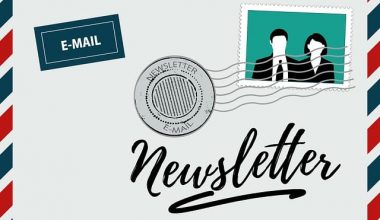When I first started working on content initiatives, a lack of direction frequently irritated me. Projects would deviate from their intended path, deadlines would be missed, and the end result frequently fell short of expectations. Everything changed after I learned the power of a well-crafted content brief. Creating a successful content brief formed the foundation of my content strategy, ensuring that everyone was on the same page and projects went smoothly. Allow me to share my experiences and ideas in generating content briefs that genuinely make a difference.
What is a Content Brief?
A content brief is a document that contains instructions and recommendations for authors while developing written content. Examples include blog entries, white papers, and social media posts.
The purpose of a content brief is to outline the key components that writers must cover in their articles. Make sure that each piece of written content contributes to your overall content goal.
Here are some examples of information that would be included in a good content brief:
- Your target audience: Demographics, interests, and pain areas can assist writers identify who their audience is.
- Your main and secondary keywords: This helps writers determine which keywords to focus on. Also, it may recommend how many times to mention a term or where to include it.
- The optimal article format: Suggestions for structuring introductions, headings, and subheadings to better meet user and search intent.
- The current search result page for your term: A review of the top-ranking pages for your chosen term. This encourages writers to fill in content gaps and make their contributions more valuable.
- Meta tags: This may contain title tags and meta description suggestions that help search engines in understanding your page’s content and influence click-through rates from search engine results pages (SERPs).
Here’s an example of what a brief with these points may look like (produced by the SEO Content Template tool):
But we’ll talk about how to find all of that information later.
Let’s start by distinguishing between content briefs and creative briefs.
Are Content Briefs the Same as Creative Briefs?
Nope. They specialize in various forms of content.
Content briefs guide the development of written content. For example:
- Blog posts.
- Video Scripts
- Social media posts.
In contrast, creative briefs guide the creation of visual deliverables such as:
- Videos
- Landing Pages
- Covers and Infographics
So, although they sound similar, they are not the same thing.
Benefits of a Content Brief
Content briefs are useful for keeping your written content focused on your main marketing strategy. While also ensuring that your content has all relevant facts.
Let’s say you have a social media scheduling app. And your goal is to increase signups.
Among other details, your content briefs will include:
- A collection of useful keywords to target.
- A list of features or goods that you can promote to get more people to sign up.
- A list of internal links you might include to keep your viewers on your website.
In this manner, you and your authors will remember to discuss the features of your tool. Whether you’re writing about Twitter’s rebranding to X or how to schedule Instagram posts,.
Using content briefs provides other benefits which include;
- They save both time and money: Briefs give writers a clear starting point. This allows individuals to do their best work while minimizing the need for editors to make extensive adjustments.
- They maintain your content on-brand: Writers are better able to incorporate your brand’s style and distinct tone into each item.
- They guarantee that each component is SEO-optimized: An SEO content brief increases your chances of ranking by informing writers about the article’s readership, target keywords, and search intent for those terms.
- They help you outperform your competitors: Writers receive a guide that identifies which themes, issues, facts, or thoughts competing articles may have overlooked (or that you believe are significant).
However, content briefs are only effective if they include all of the necessary aspects. So, here they are.
What To Include In a Content Brief
A basic content brief will include the following elements:
- A provisional, recommended title.
- Information about your target audience and their present expertise level.
- A list of your target and secondary keywords.
- The search intent for your target keyword
- The suggested wordcount.
- A collection of suggested internal links.
- A list of suggested external connections.
- A preliminary outline with potential headers.
- A link to your style guide.
Of course, there are several types of content briefs. Based on a brand’s content objectives and the type of content they wish to create.
For example, brands that aim to improve organic traffic (search engine traffic) through blog articles will develop SEO content briefs.
Those include target keywords, article length, a search engine results page (SERP) analysis, and other tips for optimizing a post.
Key Elements of a Successful Content Brief
#1. Project Overview
A brief overview of the project, including its purpose and the difficulties it seeks to answer.
Example: “This project aims to create an in-depth blog series about sustainable living, addressing common misconceptions and providing actionable tips.”
#2. Target Audience
Detailed demographics, preferences, and pain areas for the target population. According to HubSpot, 73% of consumers are more inclined to engage with content that is relevant to their interests.
When I began defining the audience more clearly in my briefs, our content’s engagement rates jumped considerably.
#3. Objectives & Goals
Clearly stated goals and methods for measuring performance.
Example: “The goal of this content is to increase website traffic by 25% over the next three months and generate 50 new leads.”
#4. Key messages
The main messages that should be delivered by the content.
Example: “Emphasize the importance of reducing carbon footprints and how small changes can make a big impact.”
#5. Tones and Style
To maintain consistency with the brand voice, guidelines for content tone and style are provided.
Example: “The tone should be informative yet approachable, with a focus on practical advice.”
#6. Content structure
An outline of the content organization, including headings, subheadings, and any additional sections that must be included.
Example: “The blog post should include an introduction, five key tips for sustainable living, and a conclusion with a call to action.”
#7. SEO and keywords
Specific keywords to target and SEO best practices to use.
According to BrightEdge, organic search generates 53% of all website traffic, emphasizing the importance of SEO.
#8. Research and sources
Any relevant background information, research, and sources should be cited.
Example: “Include statistics from credible sources such as the Environmental Protection Agency and the United Nations.”
#9. Visual elements
Guidelines for all visual elements, including photos, infographics, and videos.
Example: “Include at least three high-quality images that illustrate the tips provided.”
#10. Deadlines and Deliverables
There are clear timelines and deliverables.
Example: “First draft due by [date], final draft due by [date], and accompanying visuals due by [date].”
Recognizing the power of detail was one of the most altering experiences of my content creation path. I once worked on a project with various stakeholders and varying expectations. The lack of a precise brief resulted in numerous changes and dissatisfaction. When I began using full content briefs, the process became more efficient, and the quality of our content improved significantly.
Step By Step Guide On How to Create Effective Content Briefs
A brief forms the foundation of your content strategy. To create your first brief, follow the four steps below:
#1. Choose your story angle
You have numerous methods to tell the same narrative.
Write an op-ed, a tutorial, or an analytical take. Before you set out to write a content brief, consider the editorial direction of this post.
To determine the optimal angle, consider the following:
- Competing articles: Can you offer a new viewpoint on the subject? Does other content fail to address a vital subtopic? Find strategies to make your content stand out from the rest of the web.
- Google keyword data and search suggestions: What is the main purpose of the major keyword? Are consumers looking to be amused or educated? Separately, look through “People also ask for” questions to gain some additional suggestions for subsections.
- Check Twitter, LinkedIn, and Reddit: What are some of the most popular themes in online conversations? Is there a new trend in town? Social media is excellent for crowdsourcing suggestions for operations and current content.
- Talk with your customers: What are the most difficult issues for them? What type of expertise are they lacking? Survey people in customer service roles to better understand what information your target audience wants, needs, and craves.
#2. Do keyword research
The majority of written content today is published online. As a result, you cannot disregard on-page SEO.
Keyword research allows you to better understand the market and provide insights like the following:
- Audience interest levels: Based on the average keyword search volume for various searches.
- Competitive levels: The minimal domain authority, number of backlinks, and average word count of competitors’ content.
Both are required for creating search-focused content that delights readers and search engines.
Successful marketing teams use a two-step keyword search process.
1. Target keyword(s):
Use a generic keyword research tool such as Ahrefs or SEMrush to identify a list of primary and secondary keywords for which you wish to rank. Your keywords should be relevant to the selected story angle and the reader’s search intent.
Let’s imagine you want to write a tutorial on “hiring a freelance QA engineer.” You perceive it as a how-to guide that explains best practices and softly promotes your tech interviewing software.
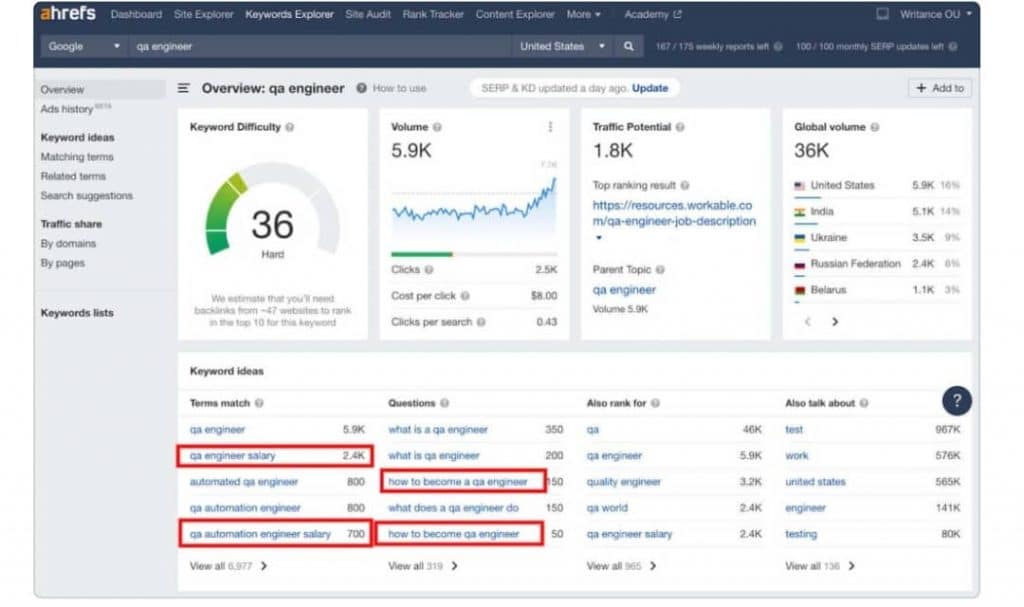
So you start with a broad term like “QA engineer” to get seed ideas for secondary keywords.
However, not every keyword ideas will be relevant to your story approach. At this stage, your goal is to eliminate terms that will generate irrelevant traffic.
Keywords like “salary” and “becoming a QA” will attract developers rather than those looking to hire them.
2. Long-tail and related keywords
You don’t always utilize the “primary keyword” while searching for information on a specific topic.
Most requests may be more conversational, such as a question or a complete statement.
Long-tail keywords, or multi-word combinations, account for 91.8% of all user search queries. Such questions typically have a more evident intent.
For example, “how to hire a freelance QA engineer” has fewer searches than “QA engineer.”
However, it is more likely to come from a potential consumer (if you are an agency) and hence more likely to result in a conversion.
Long-tail keywords are more likely to be targeted due to their high conversion potential. You should also include them in your list of keywords for the content brief.
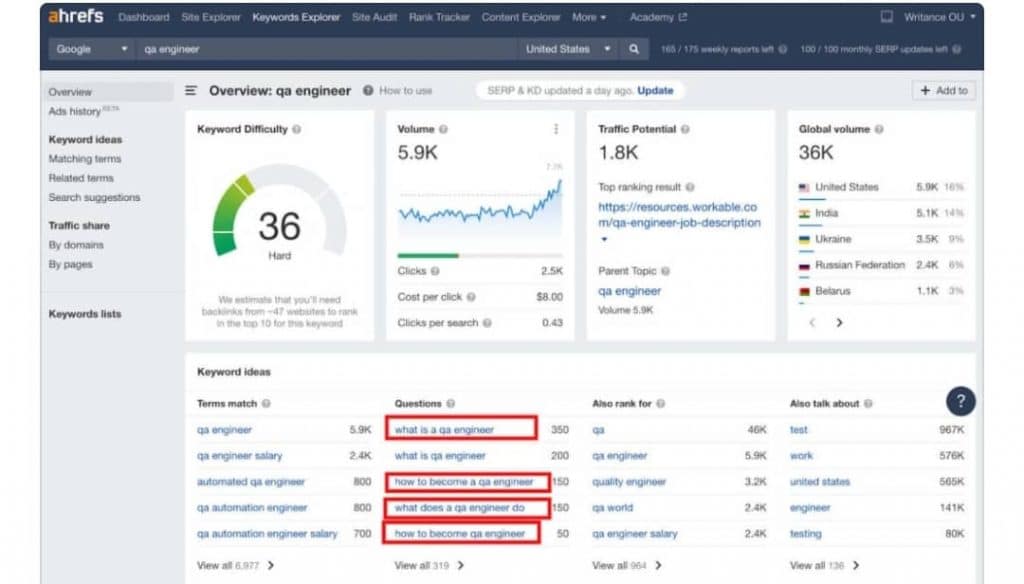
In addition, to present searchers with the most relevant results, Google algorithms use machine learning to examine “words frequently occurring together to induce query similarity and generate topics.”
Google seeks to gain a better understanding of the crawled web content by statistically assessing how frequently certain word combinations appear in articles on similar themes.
In this manner, it may recommend the most relevant content to visitors depending on their expected search intent.
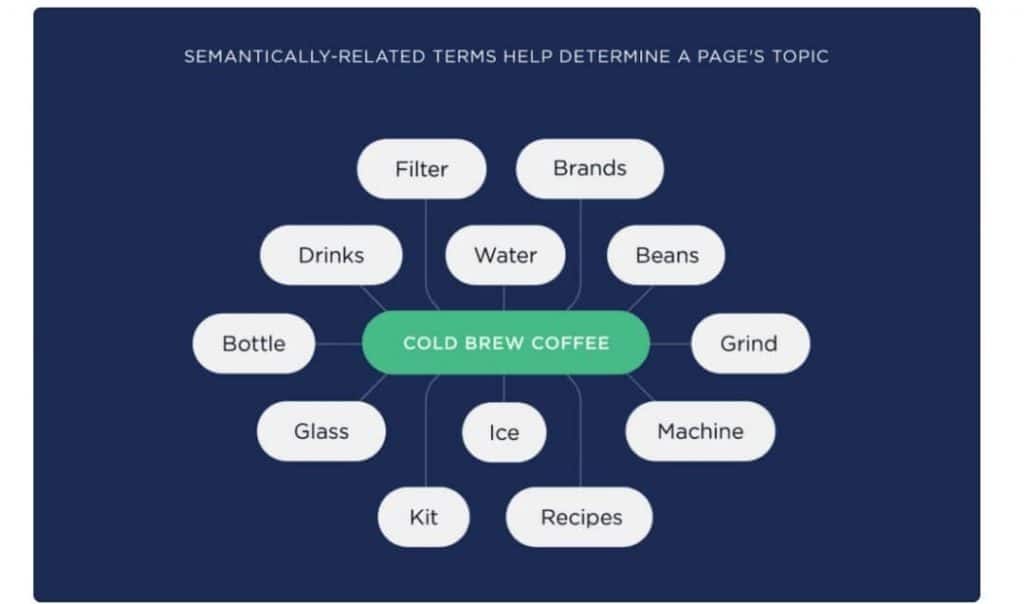
Such linked keywords can also increase your chances of ranking content for a broader range of keyword clusters and driving more organic traffic.
However, searching for them manually is time-consuming. This is when different SEO content optimization tools come in handy.
Such software can generate a list of long-tail and related keywords for use in your copy, blog posts, or landing pages.
Read Also: The 13 Landing Page Optimization Tools Experts Don’t Want You Using (Because They’re Too Effective)
Some systems additionally provide an average word count and content reading level based on rival articles.
These data are especially essential since Google uses user-behavior signals like page dwell time, bounce rate, repeat visits, and others to rank content.
Most programs have an “Optimize” interface where you may paste your content and ensure that all primary, secondary, and related keywords are included, as well as that all user experience checkboxes are checked.
Popular content optimisation tools include:
- Clearscope
- Surfer SEO
- MarketMuse
- Content Harmony
Note: Such techniques are ideal for search-focused, TOFU (top-of-funnel) blog entries. However, they are less effective for MOFU (middle-of-the-funnel) pieces or brand-building content like thought leadership postings, journalistic reporting, or original research.
Most optimization tools produce keywords by evaluating top-ranking articles for primary keywords, thus, they encourage you to mimic the content structure of other pieces.
This strategy may lead a marketing team to repeat the same topics rather than providing an innovative perspective.
#3. Organize all internal information
A content brief bridges the gap between your understanding of the subject and the writer’s.
Your writer can (and should!) conduct extensive research to create unique, interesting, and thorough content. However, its your duty to assist them in aligning their thinking with your marketing objectives and identity.
So that each new piece of content appears consistent with the others and does not contradict any other message your organization is distributing.
For the reasons listed above, your content brief template should include the following components:
1. Post Summary and Objective(s)
Include a synopsis of your article’s concept and story perspective. You can also specify the primary takeaway(s) readers should remember after reading the article. Then, briefly outline the “why” behind this work, which is what you are aiming to accomplish. For example, “educate on topic X” or “suggest alternative ways to do Y.”To avoid second-guessing, supply the writer with material that inspired the viewpoint or contributed to the concept (such as a Tweet thread or a recent conference talk).
2. Editorial Style Guide
An editorial style guide is a set of guidelines for preferred content structure, tone of voice, and overall brand positioning. Every big news organization is led by one, and so should content teams! An editorial style guide promotes consistency and reduces the amount of copy-editing required for each blog article. It improves your content workflow and makes your editors happy!
A decent style guide covers the following:
- Rules specify renderings, syntax, and abbreviations.
- Punctuation preferences (for example, whether to use an Oxford comma or not).
- All brand names, product/service lines, and other terms must be spelled correctly.
- The preferred spelling of neologisms (for example, ecommerce vs e-commerce).
- Brand tone of voice – the level of formality and overall mood.
- Formatting rules include typefaces, sizes, and the use of h2/h3/h4.
- Any additional types of editing requests you frequently receive.
An editorial style guide established once saves you ten times the effort spent revising.
3. Overview of the target audience
Provide a brief description of your intended audience. It allows the writer to better grasp the content depth required and arrange the article around the persona’s major goals or obstacles.
For example, suppose you want to write a content brief for a blog article titled “debt financing.”
The style and content of a copy meant for senior decision-makers in the banking sector will differ greatly from those intended for new college grads looking for student loan refinancing.
Bonus point: To acquire the best copy, provide your writer an ideal “buyer persona” or “content personas” file!
4. Reference Materials
High-quality content demonstrates your understanding. Include pertinent internal and external links that the writer might use as a reference while writing.
Also, include any relevant external research links you obtained when writing a content brief to ensure everyone is on the same page. It could contain:
- Customer Case Studies
- Relevant industry reports.
- Recommended books, videos, and articles.
- Quotes by team members or subject matter experts
- Interview transcripts.
- Internal study data.
- Product manuals or demonstration videos.
- Accepted marketing claim
Include design mockups in creative briefs, infographics, and landing pages. These will make it easy to correctly size the copy for the layout.
5. Visuals
Every marketer understands that relevant graphics increase engagement and make content more digestible. Include guidelines for sourcing photos or providing notes and references to the design team.
Suggested visuals include statistics, graphics, product screenshots, and illustrations.
Recommended picture width, length, and format (.jpg,.png).
The required amount of photos per post is one (for every 1,500 words).
Also, please specify how you want the writer to share these with you. Upload to a specified folder, host on a file sharing platform, send as an attachment, and so on.
6. Calls To Action (CTAs)
A call-to-action (CTA) is a catchphrase that encourages the reader to take a particular action. Purchase a product, get an eBook, request a demonstration, etc.
If you produce content briefs for MOFU/BOFU assets, indicate the type(s) of CTAs you require and where they should appear.
For example, you can include a message that states:
- A product demo requests CTA in the middle of the copy
- One “contact us” CTA in the final paragraph.
- Other Technical Bits
Finally, include any additional needs for content, sources, styling, and so on.
You could mention:
- Important deadlines: first draft, final copy, etc.
- SEO title and meta description criteria.
- Competitors should avoid linking to or referencing in their copy.
- Acceptable publication dates for reference materials (statistics from 2018 or before).
- The amount of expert quotes to collect and include.
- Minimum content score for an SEO optimization tool.
- The highest copy readability grade (e.g., college-level).
- Trademark requirements cover accurate spelling, common taglines, and trademark catchphrases.
- Any more notes about personal preferences (or pet peeves).
Read Also: Crafting CTAs That Convert: Perfecting the Press Release CTA for Explosive Growth
#4. Create an outline
An outline enables your writer to create high-quality content based on your vision.
It encourages them to approach the topic from a specific perspective and build the narrative around your keyword research.
A strong outline fills up the key areas of the post. Headings, sub-headings, lists, and essential or suggested talking points or suggestions for the writer.
Read Also: How to Create an Effective PR Coverage Report (+ Free Templates)
Returning to our example of “hiring a freelance QA engineer,” here’s how a sample blog post outline for the writer may look:
H1: Hire a Freelance QA Engineer for Your Next Project.
A catchy introduction. Set the scene for the reader; address their needs and concerns. You can explain why QA is such a vital element of software development. How does it save brands money and reputation?
Suggested statistic: Poor software quality in legacy systems costs the US economy more than $1.56 trillion annually.
H2: What Does a Quality Assurance Engineer Do?
Give a concise outline of the profession. Explain who they report to and how they work with other team members.
Focus on automation QA engineers rather than manual testers.
A QA engineer’s main roles are:
Test case creation
Test script authoring
And more common duties.
H3: Do Quality Assurance engineers write code?
Write a brief (100-word maximum) response optimized for featured snippet results.
H2: Tech Recruiters’ 3 Tips for Hiring a Freelance QA Engineer
Short lead section.
H3: 1. Create a role description.
Explain how to write an internal description for a QA engineer. Mention how to determine a candidate’s seniority level.
For advice and pointers, check out Jane D.’s interview. Include a direct quotation.
H3. 2.Look beyond freelance talent marketplaces.
Create an argument for why recruiting from freelance talent marketplaces isn’t the best option. Give clear examples.
Look into Terry M.’s interview transcript for reasons, and provide one quote from them.
H3: 3. Prepare for a technical interview.
Provided advice on how to structure an interview. Explain how to set up an async static code review. For more information, please refer to both interviews.
Include a soft promotion of our product as a tool for conducting remote technical interviews.
H2: Conclusion.
Create a brief, summary paragraph. Keep it positive.
Pro tip: If you’re working with an experienced writer, ask them to build content outlines based on the keywords and data points you supply. It can save a lot of time for your internal content staff.
Practical Tips for Creating Effective Content Briefs
#1. Collaborate with Stakeholders
Include all key stakeholders in the briefing process to ensure that their requirements and expectations are satisfied. This comprises marketing departments, content creators, SEO specialists, and even sales teams.
#2. Be Specific
Give as many details as possible to avoid ambiguity and misinterpretation. Specificity in goals, audience details, and key messaging will result in a more focused and effective content piece.
#3. Utilize a Template
To make the process easier, utilize a content brief template. This ensures that all relevant information is provided and that consistency is maintained across projects. A template can also help save time and ensure that no important details are forgotten.
Are you ready to build your own content brief? Download our Content Brief Template today and begin planning your content projects with accuracy and clarity. This template will provide a clear roadmap to help you easily reach your content marketing objectives.
#4. Include Visual Examples
Sometimes words alone aren’t enough to express the desired tone and style. Include visual examples, such as screenshots or links to existing content, that align with your goal. This can help content authors be more effective.
#5. Update the Brief Regularly
Your content briefs should evolve alongside your content strategy. Update your template regularly to reflect new insights, lessons learned, and strategic adjustments.
#6. Establish Practical Deadlines
Make sure the deadlines you establish are practical, taking into account the time required for research, writing, editing, and any changes. Unrealistic timelines can jeopardize the quality of content.
#7. Provide Context and Background
Do not assume everyone is on the same page. Give context and background information on the project, the brand, and any past content that may be relevant.
#8. Highlight Key Metrics
Define the metrics that will be used to assess the success of the content. This could include page visits, engagement rates, lead creation, and any other relevant indicator.
#9. Encourage input
Once a content item is complete, get input from all stakeholders. Use this feedback to improve future briefings and content creation processes.
#10. Incorporate User Personas
Include specific user personas in your brief to help content authors understand who they’re writing for. This can help you create more targeted and effective content.
Content Brief Examples
Following examples is one of the most efficient ways to acquire a new skill.
Here are three example briefs for developing various types of materials for your content strategy.
#1. Content Brief Example of a Blog Post
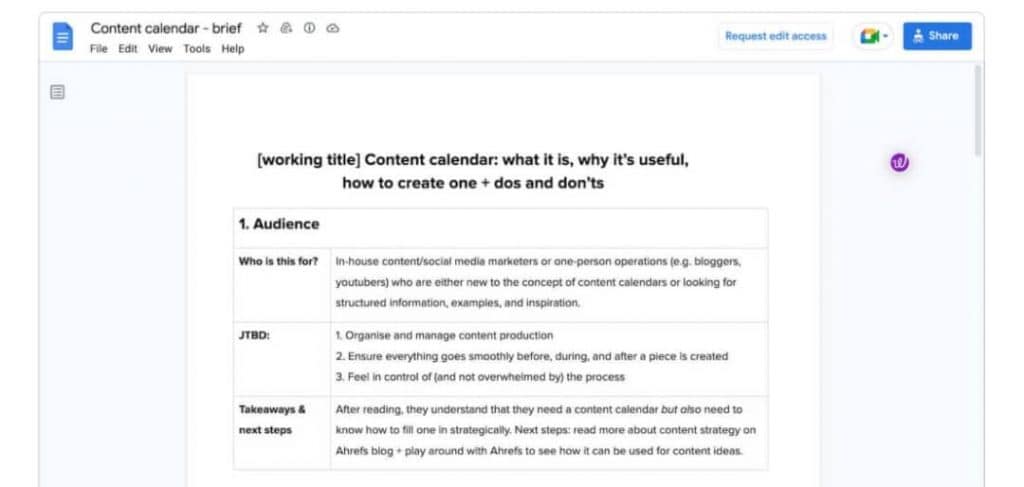
This content brief begins with an audience overview and discusses what tasks the reader hopes to complete.
Then it offers a story angle to the writer and includes important search engine optimization (SEO) information, including primary and secondary keywords, search intent, internal linkages, and other details.
#2. SEO-Focused Content Brief Example
If your primary goal is to attract traffic from search engines, your content brief should focus on on-page optimization criteria.
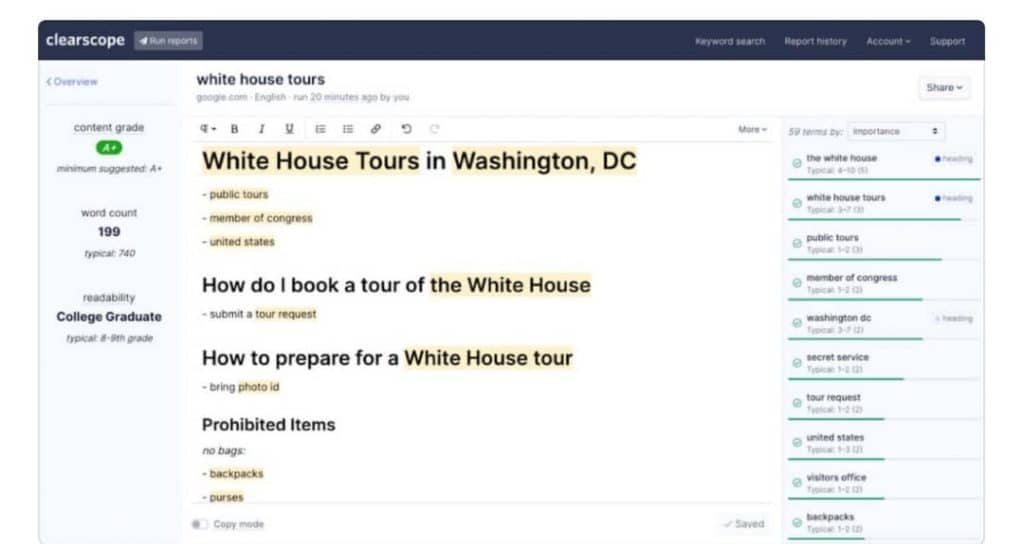
SEO-friendly content is built around keyword research.
Once you have a list of primary and secondary keywords, brief the writer on:
- SEO Titles
- Meta descriptions.
- Primary keyword.
- Secondary Keyword Placements
- Optimal word count
- Suggested H2/H3 titles
- Number of external links.
- Must have internal linkages.
- Recommended anchor texts for both
- Competitor articles to examine
Many keyword research tools (more on this in the following section) also have SEO content improvement features.
This makes it easy for the writer to develop content that meets your SEO standards. You also have a better chance of ranking higher in search results for targeted keywords and creating a consistent stream of organic visitors.
#3. eBooks Content Brief Examples
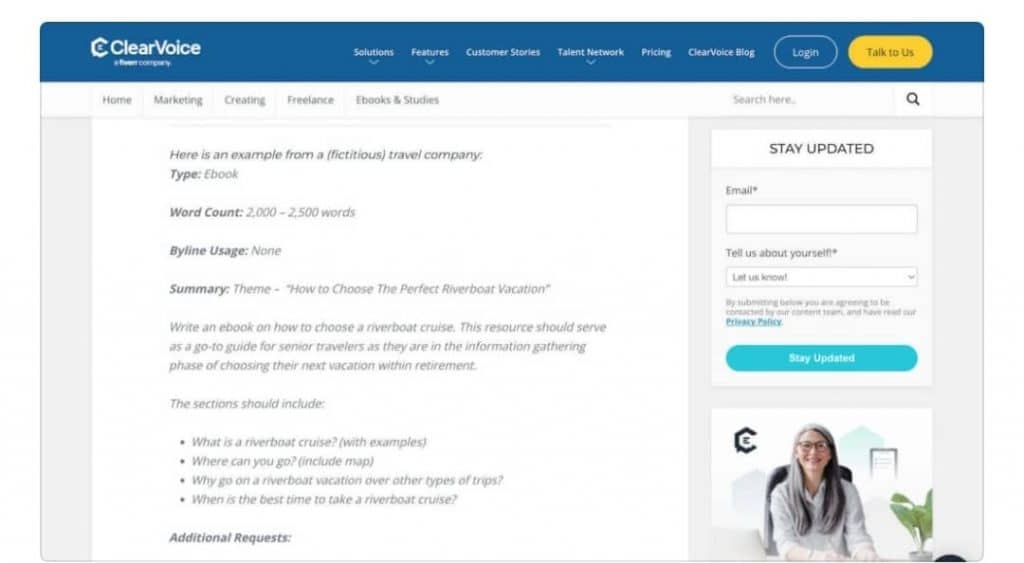
They use a 5W structure to clarify what information you need to provide.
- What? General information about the content item and its purpose.
- When? Due dates and project milestones.
- Where? Content publication location and dissemination method(s).
- Who? Information about the target population and their primary pain areas.
- Why? Your content marketing objectives and the purpose of this essay.
When Should I Utilize a Content Brief?
A content brief should always be used when working on a content project involving more than one individual. The more people participating, the more you’ll require an excellent content brief. It’s the most effective approach to keep everyone on the same page and deliver content that meets its objectives.
However, even with the best brief, a huge team does not produce exceptional content. Too many stakeholders can dilute the piece’s central message.
A brief might also be useful when working just on content. It helps you arrange your ideas, research, and keywords so you don’t forget anything or waste time creating irrelevant content. When working alone, you can typically avoid much of the structure of a broader brief in favor of critical research and the content outline itself.
Should I Use Templates for Content Briefs?
Yes, you should. Drafting briefs from scratch for each piece of content is a waste of time, especially since creating outstanding content briefs may be time-consuming.
A template allows you to recall everything you need to explain. When writing a brief without a template, it’s easy to overlook background information that’s critical to guiding the content, such as the buyer persona, sales funnel stage, or necessary internal linkages. Templates prevent this by providing a structure to keep your content brief, orderly, and easy to navigate.
Conclusion
Developing a compelling content brief is critical to the success of any content production. It aligns the team, explains goals, and ensures that the final product fulfills expectations. By following the steps provided in this article, you’ll be well on your way to writing content that resonates with your target audience and meets your business goals. What obstacles have you encountered in creating content briefs, and how do you intend to address them? Let us continue the conversation!
Related Articles
- How to Become a Content Marketing Strategist in Nigeria 2024
- Content Syndication: A Comprehensive Guide
- Content Team: How to Build & Grow an Effective Content Team
- What Is Creative Content? All You Need 2024
- Content Development Best Practices for Higher Engagement

